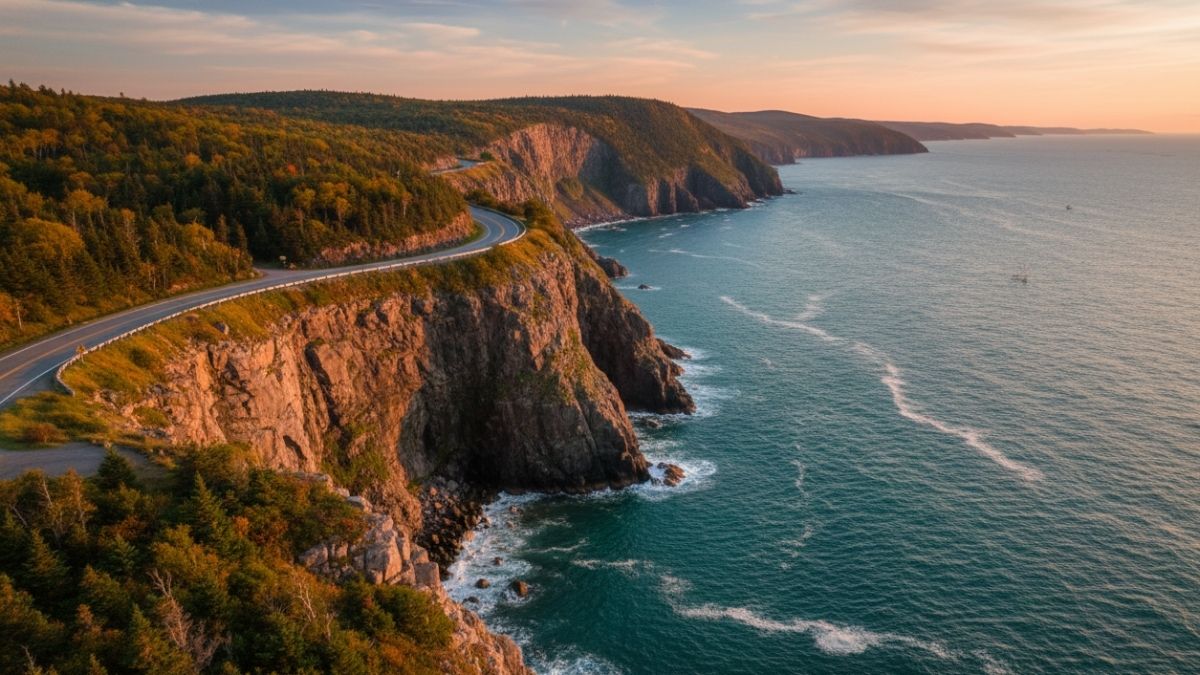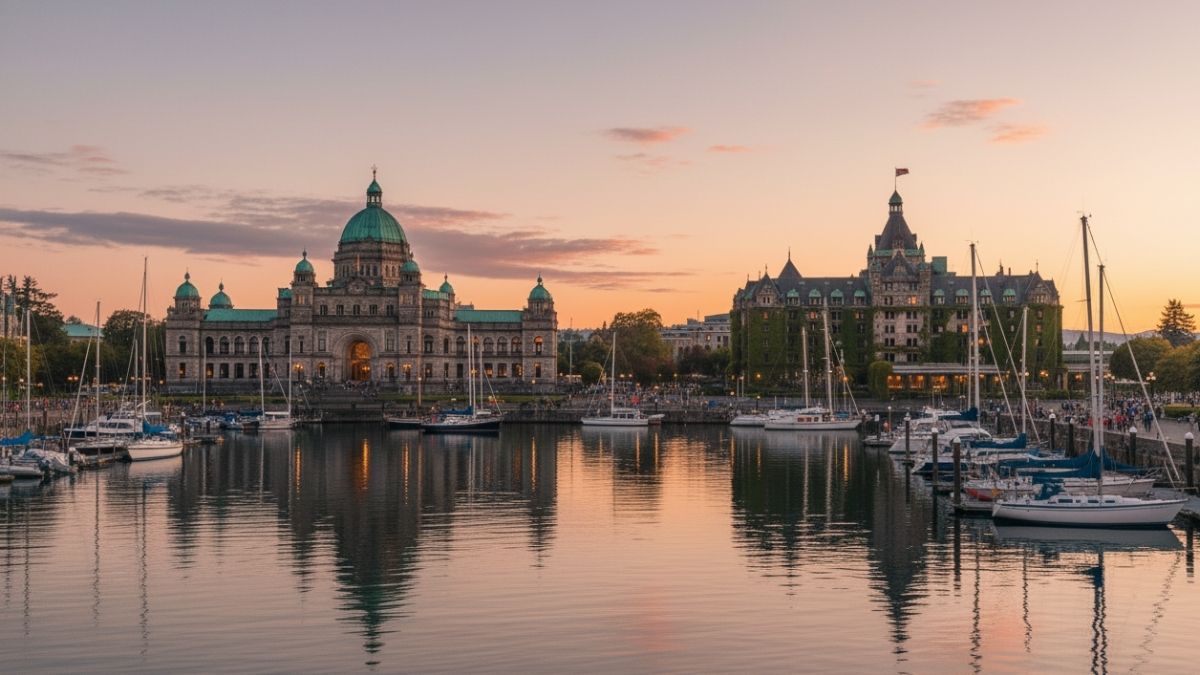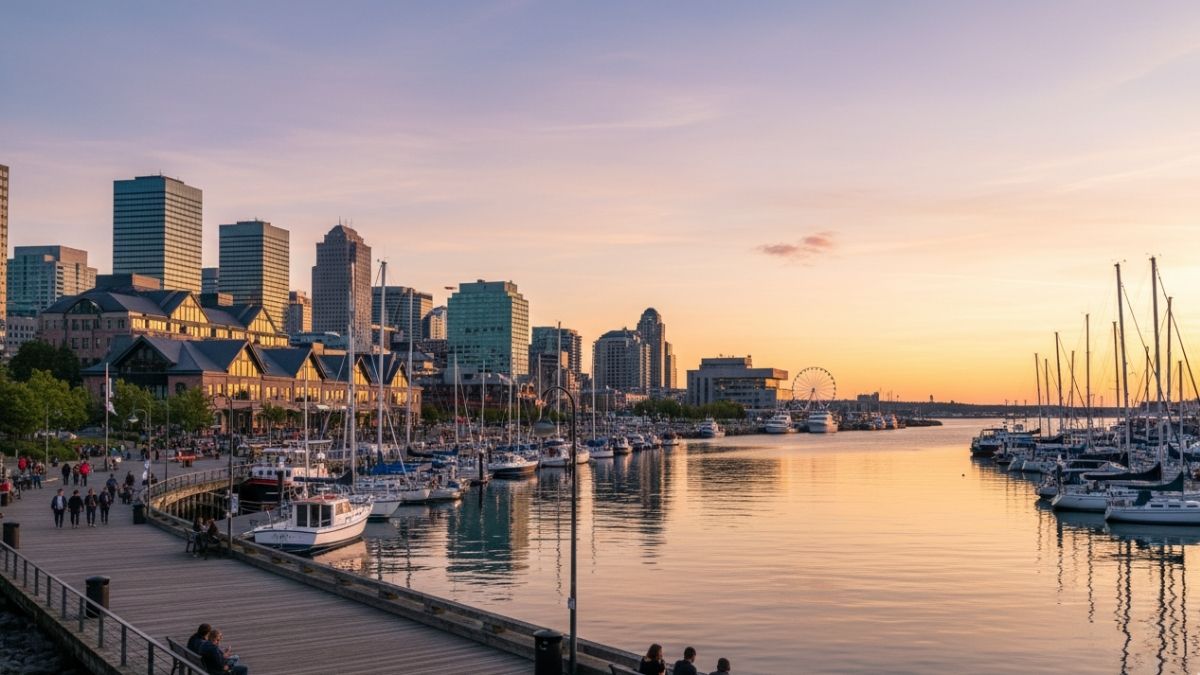If you’ve ever dreamed of walking through cobblestone streets lined with café patios, hearing French melodies echo through ancient stone walls, and gazing over the mighty St. Lawrence River from a cliffside fortress, Quebec City is calling your name.
This place isn’t just a stop on a map—it’s an experience that mixes European charm, North American warmth, and a deep sense of history you can feel in every corner. So, if you’ve been wondering “Is Quebec City worth visiting?” or searching for a detailed Quebec City travel guide, you’ve landed in the right place.
If you’d love the complete Quebec City experience — with detailed itineraries, smart packing tips, local laws, and insider money-saving advice — grab your FREE Quebec City Travel Guide eBook today.
But if you prefer something to flip through. You can also order the paperback on Amazon or Lulu Bookstore.
Simply enter your name and email below to get instant access to your free download.
Planning your next trip just got easier with WorldTourGuide. And while you’re at it, don’t miss our Traveler’s Toolkit — trusted by explorers worldwide to plan smarter, pack lighter, and travel better. You’ll thank yourself later for making this choice.
Here at WorldTourGuide, we’ll help you explore the city like a local—through its stories, scenery, and soul.
Geography and Historical Landmarks of Quebec City
Perched dramatically on the cliffs of Cap Diamant, Quebec City overlooks the St. Lawrence River and wears its history proudly.
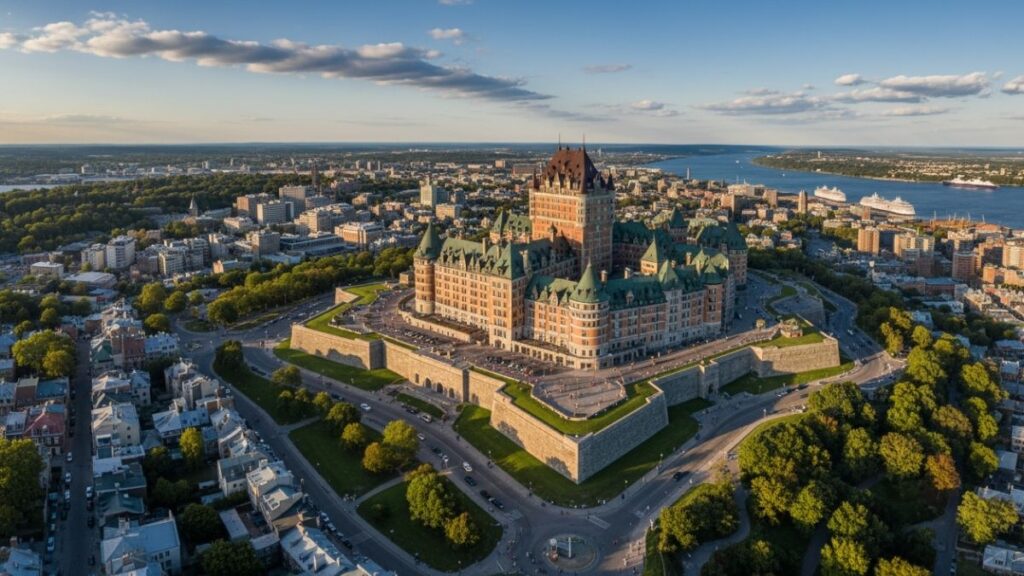
This is one of the oldest cities in North America, founded in 1608 by Samuel de Champlain, and still the only fortified city north of Mexico with its original walls intact.
The geography gives it its fairytale appearance. The city is divided into two main sections: Upper Town (Haute-Ville) and Lower Town (Basse-Ville). Upper Town is the historic core—home to landmarks like Château Frontenac, the Citadel, and Dufferin Terrace, all offering panoramic river views. Down below, in Lower Town, the vibe turns cozy and creative with boutique shops, cobblestone alleys, and Place Royale, one of the oldest public squares in North America.
When you stand in Old Quebec (Vieux-Québec), a UNESCO World Heritage Site, you’re literally walking through four centuries of stories. You can still see where the French defended their colony, where British soldiers marched, and where the modern city now thrives with music and culture.
Don’t miss La Citadelle, an active military fortress offering guided tours and a Changing of the Guard ceremony during summer. And right nearby, the Plains of Abraham—now a massive public park—was once the site of the decisive 1759 battle between the French and British. Today, it’s where locals picnic, jog, and attend outdoor concerts.
If nature calls you, head to Montmorency Falls, just a 15-minute drive away. It’s taller than Niagara Falls and has hiking trails, cable cars, and a suspension bridge for unbeatable views. Quebec City’s geography and history blend seamlessly—majestic cliffs meet cobblestone charm, and every view feels like stepping into a painting.
For a full guide to attractions, neighbourhoods, and history, visit the official Québec City Tourism site.
How to Get to Quebec City
Getting to Quebec City is straightforward whether you’re coming from within Canada, the U.S., or overseas.
By Air:
The city’s main airport, Jean Lesage International Airport (YQB), is just 20 minutes from downtown. You’ll find direct flights from cities like Toronto, Montreal, New York, and Chicago. Taxis, rideshares, and public buses (RTC Route 76) are available right at the terminal.
By Train:
Travelers who love scenic journeys should take VIA Rail from Montreal or Ottawa. The train arrives at Gare du Palais, a charming station in Old Quebec that feels straight out of Europe. The 3.5-hour ride from Montreal is comfortable, Wi-Fi-equipped, and full of countryside views.
By Road:
If you’re driving from Montreal, take Autoroute 20 or Autoroute 40—a 3-hour scenic trip with plenty of rest stops. If you’re coming from the U.S.? Cross the border through New York State or Vermont, then follow signs to Quebec City. Just remember: signs are in French, and speed limits are in kilometers.
By Bus:
Orléans Express runs regular routes from Montreal and Ottawa to Quebec City. It’s affordable, comfortable, and drops you right downtown near Gare du Palais.
Once you arrive, you’ll quickly realize that Quebec City is compact and walkable. Bring comfy shoes, and you’ll barely need a car to explore the main attractions.
Plan your trip using Bonjour Québec, the official tourism portal for the province.
Best Areas to Stay: Pros & Cons
Choosing where to stay in Quebec City depends on your vibe—romantic, artsy, or budget-friendly. Let’s break it down.
1. Old Quebec (Vieux-Québec)
If you want that postcard-perfect setting, this is it. You’ll be steps away from Château Frontenac, cobblestone alleys, and cozy cafés.
Pros: Unbeatable atmosphere, walkable, packed with history.
Cons: Expensive and crowded in peak season.
Perfect for: First-timers and couples.
2. Saint-Jean-Baptiste
Just outside the city walls, this colorful neighborhood offers local eateries, street art, and boutique hotels.
Pros: Cheaper than Old Quebec, great dining, less touristy.
Cons: Hilly streets and limited luxury stays.
Perfect for: Foodies and solo travelers.
3. Montcalm (Art District)
Peaceful, elegant, and full of culture. Near the Plains of Abraham and museums.
Pros: Quieter, family-friendly, great art galleries.
Cons: A bit farther from main attractions.
Perfect for: Families and art lovers.
4. Saint-Roch
Trendy, youthful, and creative—Quebec City’s hipster corner.
Pros: Craft breweries, cool cafés, affordable stays.
Cons: More modern than historic. Perfect for: Budget travelers and digital nomads.
5. Limoilou
A residential gem with local vibes and leafy streets.
Pros: Affordable, authentic, filled with great local food.
Cons: Requires a short bus ride to Old Quebec.
Perfect for: Repeat visitors and slow travelers.
No matter where you stay, Quebec City’s size makes it easy to explore all corners without much travel time.
N.B.: If you organize your trip early and pack smart using our recommended travel gear essentials and trusted travel and affiliate partners below, you’ll skip the “I wish I knew” stress. From booking flights to finding the best travel deals, these are the gears that make every journey smoother — and save you money while you’re at it.
3-Day Family-Friendly Itinerary
Day 1: Old Quebec Magic
Start your morning at Café La Maison Smith for croissants and coffee. Wander through the Upper Town, snapping photos at Château Frontenac and Dufferin Terrace. Take the Funiculaire down to Lower Town and stroll through Quartier Petit Champlain—a storybook neighborhood perfect for souvenir shopping. End your day with dinner at Le Cochon Dingue, a lively spot that kids will love.
Day 2: Culture and Nature
Begin at La Citadelle to watch the Changing of the Guard, then picnic on the Plains of Abraham. In the afternoon, head to the Aquarium du Québec, home to polar bears and jellyfish. Dinner? Try Ciel! Bistro-Bar, a rotating restaurant with panoramic views of the city.
Day 3: Waterfalls and Local Markets
Take a morning trip to Montmorency Falls. Walk the suspension bridge or ride the gondola for breathtaking views. Return to town for lunch at Marché du Vieux-Port, where you can sample local cheese and maple treats. Wrap up your visit at the Musée de la Civilisation, an interactive museum perfect for families.

Festivals and Entertainment
Quebec City knows how to celebrate—no matter the season.
Winter Carnival (Carnaval de Québec) in February transforms the city into a snow-covered wonderland with parades, sculptures, and the famous Bonhomme snowman.
In summer, the Festival d’été de Québec draws global artists for 11 days of open-air concerts on the Plains of Abraham—it’s Canada’s version of Coachella, but with French flair.
For history buffs, Fêtes de la Nouvelle-France in August brings 17th-century Quebec to life with costumes, parades, and reenactments. And if laughter is your thing, ComediHa! Fest fills the streets with comedians performing in both French and English.
Even outside festival season, street performers, live bands, and open-air shows bring Old Quebec to life almost every evening.
Local Laws Tourists Should Know
Don’t let a small mistake ruin your trip—Quebec City has its own set of rules.
- Drinking: Legal age is 18. You can only drink in public if you’re having a meal (like a picnic) in designated parks between 8 a.m. and 11 p.m.
- Smoking: Smoking and vaping are banned within 9 meters of doors, windows, and patios. Cannabis is legal but follows the same restrictions.
- Driving: The legal blood alcohol limit is 0.08%, but for young or new drivers, it’s zero tolerance. Always wear seatbelts and respect the speed limits posted in kilometers.
- Tipping: Expected everywhere—usually 15–20% in restaurants and taxis.
- Noise: Keep it down at night, especially in Old Quebec where echoes carry.
Respecting these laws keeps your trip stress-free and helps you blend in like a local.
Tips for Staying Safe and Aware
Quebec City is one of the safest places in North America. Still, a few tips help you travel smarter:
- Keep valuables close in crowded areas.
- Use official taxis or rideshares late at night.
- Avoid jaywalking—yes, you can be fined!
- In winter, watch for icy sidewalks.
- Learn a few French phrases like “Bonjour” and “Merci.” It goes a long way with locals.
Emergency number? It’s 911, just like in the U.S.
Learn about getting around, parking, and local tips on the Ville de Québec tourist information page.
Tipping, Taxes, and Payment Practices
Let’s be honest—money etiquette can get confusing abroad. Here’s what to know in Quebec City:
Tipping:
- Restaurants and cafés: 15–20%
- Bartenders: $1–$2 per drink
- Taxis: 10–15%
- Hotel staff: $2–$5 per bag or per day
Taxes:
Two taxes apply to most purchases—GST (5%) and QST (9.975%)—so prices are about 15% higher than the tag.
Payments:
Credit and debit cards are widely accepted, and tap-to-pay (Apple Pay, Google Pay) works almost everywhere. Still, carry a bit of cash for small local markets. Canadian dollars only—U.S. dollars aren’t usually accepted.
Before we wrap up this travel guide, here’s some exciting news you won’t want to miss!Our travel media agency, WorldTourGuide, has officially launched a Sponsored Trip Program — a one-of-a-kind opportunity where our most active fans, like you, can earn the chance to explore their dream destination.
If you’re ready to see where this journey could take you. Click here to discover how the program works and learn how you can join this purpose-driven adventure.
Final Thoughts — You’ll love Canada’s most European destination.
Quebec City isn’t just another destination—it’s a living postcard where the past meets the present.
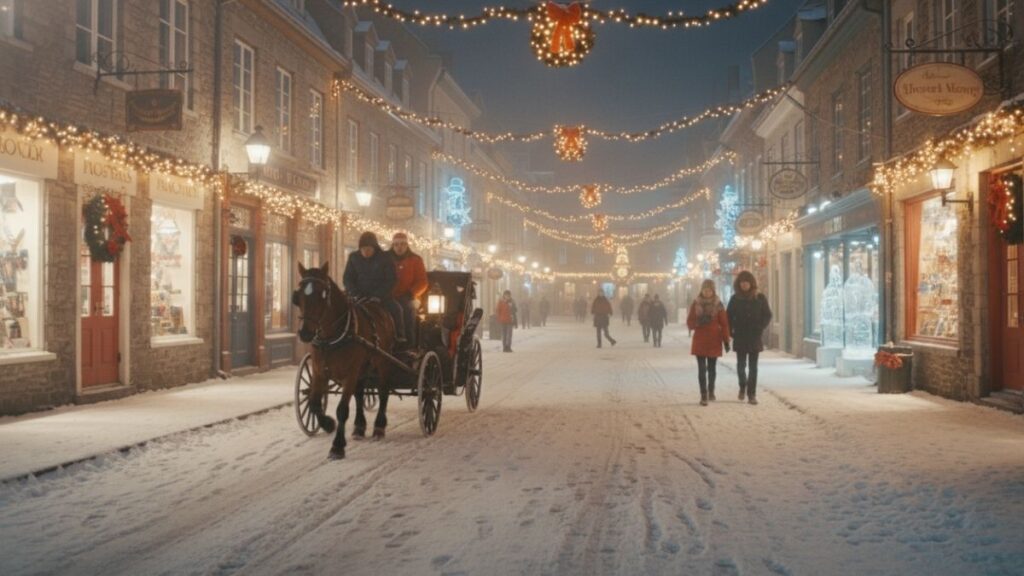
From castle-like hotels and cobblestone streets to festivals, waterfalls, and warm hospitality, it’s a city that captures hearts easily. Whether you’re here for a weekend or a week, you’ll find yourself swept up in the rhythm of French-Canadian culture and beauty at every turn.
And that wraps up our journey through Quebec City! I’m wishing you safe travels and unforgettable moments as you explore this incredible island.
So pack your bags, charge your camera, and come see why Quebec City truly deserves its title as Canada’s fairytale capital.
📘 Don’t forget your FREE Quebec City Travel Guide eBook — if you missed it earlier, simply enter your name and email in the box below to get instant access.
You’ll also receive future updates, insider travel tips, and exclusive offers from WorldTourGuide to help you plan smarter and travel better.


